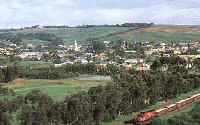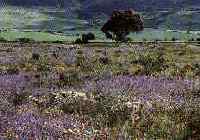
 |
Route 27 West Coast South AfricaWest Coast Towns: Darling |
West Coast R27 Route 27 West Coast Towns Off the Beaten Track West Coast History Culture & History From Crayfish to Iron West Coast Map West Coast Explorer SA West Coast Tours/Recreation Nature Reserves Fossil Park Sea Tales & Wrecks > Whale Watching Weskus Stories |
 Darling, the 'flower village' is 72km from Cape Town and 25 km from Yzerfontein and is easily reached by road or rail. The district's farming activities place the town in the Swartland, while it's wealth of wild flowers make it a West Coast town par excellence Darling, the 'flower village' is 72km from Cape Town and 25 km from Yzerfontein and is easily reached by road or rail. The district's farming activities place the town in the Swartland, while it's wealth of wild flowers make it a West Coast town par excellenceThe town is a thriving agricultural centre, concentrating on dairy, wheat, grapes, peas, potatoes and sheep farming. There are several industries, including a textile factory, basket weavery, clothing factory and some light engineering shops.
Historical BackgroundThe town lies in the the region formerly known as De Groene Kloof (the Green Valley).In 1682 a Dutch East India Company (VOC) official, Oloff Bergh, undertook an expedition to the north and his records show that he passed through the valley.By 1853 there were already many farms in the area. The town itself arose around the Dutch Reformed congregation on the farm Langefontein and was called Darling after Sir Charles Henry Darling, who arrived at the Cape in 1851 as Lieutenant Governor. The town gained municipal status in 1955; since then it has made concerted efforts to market its tourist attractions. Over time it has gained a reputation as a botanical centre, thanks to its profusion and variety of wild flowers.
Also Read on West Coast History:
Attractions The town's wild flower splendour is undoubtedly its biggest attraction. A wide range of bulbous plants and other annuals make up its floral wealth. For the largest part of the year, the veld is dominated by a few perennial shrubs but in spring, more than 1000 species of flowering plants emerge. This astonishing variety makes the region unique. The town's wild flower splendour is undoubtedly its biggest attraction. A wide range of bulbous plants and other annuals make up its floral wealth. For the largest part of the year, the veld is dominated by a few perennial shrubs but in spring, more than 1000 species of flowering plants emerge. This astonishing variety makes the region unique.Lovers of wild flowers can also visit private nature reserves, including the Harold Versfeld Reserve on the farm Contreberg some 10km out of town and the Waylands and Oudepost reserves just outside Darling. parts of these two farms are open to the public during the wide flower season. The biggest orchid nursery in South Africa is found on the farm Oudepost. Here millions of exotic blooms are grown for both the domestic and export markets. As far back as 1915 a Mr FW Duckitt and a Ms DJ Malan laid the groundwork for a Wild Flower Society and in 1917 the first Wild Flower Show was held. Since then this show, which takes place during the third weekend in September, has become an annual event drawing large numbers of tourists. An orchid show is presented at the same time. The Tienie Versfeld ReserveJust outside Darling on the way to Yzerfontein is the Tienie Versfeld Veld Flower Reserve. This is part of a farm donated to the National Botanical Society of South Africa by Mr Versfeld. In this botanical reserve, which covers an area of just over 20 ha, an attempt has been made to preserve a piece of the Sandveld with its characteristic variety of flowering species. The reserve is open to visitors throughout the year, although it is most popular in spring when its fields of wild flowers are dazzling. Although a large variety of wild flowers is found here, this reserve is particularly valued for its bulbous plants.The Darling MuseumThis museum in Pastorie Street is housed in the old city hall, which was built in 1899. Darling is one of the three biggest dairy-producing areas in the Western Cape. The old dairy co-operative, the Darling Creamery, was found in 1902 and in 1914, a large factory was built in the town. Darling Butter had a place on supermarket shelves for many years until a new butter factory was erected at Paarden Eiland in 1950.The original butter museum forms part of the Darling Museum. Apart from tracing the history of the dairy industry, the museum also records the founding and development of the town, its school and community. The Signal CannonThe cannon, which was first mounted on Klipberg in 1734, where it served to warn burghers of danger or to summon them to town, now stands in front of the municipal offices. However, its main function was to notify farmers in the region of the arrival of ships visiting the Cape, thus enabling them to take their produce to Cape Town for sale. The cannon serves as a valuable reminder of the history of the region.The Hildebrand MemorialThis memorial is 6km to the north of Darling on the farm Kraalbosdam. it was erected to commemorate the southernmost skirmish of the Anglo-Boer War (1899-1902).Field Cornet C P Hildebrand of the Boer Forces' Maritz Commando fell in battle on the farm on 12 November 1901 and was buried there. His white marble gravestone was incorporated into the memorial obelisk when it was erected in 1939. Click here to read the history of Hildebrand. Special events and recreational facilitiesEvery year on 10 October an equestrian day is held in town. this event, dating back to 1927, used to be a great social event. Although it has since lost some of its splendour, it is still well attended.Some 15km out of town there is a holiday farm with a riding school. Here horse lovers, especially children, are schooled in all aspects of horse riding. At the same time one can experience all the excitement of life on a farm. Darling is also proud of its golf course and sports club where the annual wild flower show is held. Author and photographs - Cornel Truter, West Coast Tourist Guide
|